
 |
Re: Terry's Astronomy Thread.
What's in the sky tonight?
November 20, 2012 -First-quarter Moon (exact at 9:31 a.m.). The Moon shines high in the south in early evening, below the Water Jar of Aquarius. -Saturn (magnitude +0.6, in Virgo) is lower left of bright Venus before and during dawn. They appear closer together every day. They're on their way to a conjunction less than 1° apart on the American mornings of November 26th and 27th. Astro Picture of the Day: November 20, 2012  Have you ever seen a halo around the Moon? This fairly common sight occurs when high thin clouds containing millions of tiny ice crystals cover much of the sky. Each ice crystal acts like a miniature lens. Because most of the crystals have a similar elongated hexagonal shape, light entering one crystal face and exiting through the opposing face refracts 22 degrees, which corresponds to the radius of the Moon Halo. A similar Sun Halo may be visible during the day. The setting of the above picture is Athens San Sebastian, Greece. The distant planet Jupiter appears by chance on the halo's left. Exactly how ice-crystals form in clouds remains under investigation. |
Re: Terry's Astronomy Thread.
What's in the sky tonight?
November 21, 2012 -Algol is at minimum light again, for a couple hours centered on 7:34 p.m. EST. Algol takes several additional hours to rebrighten. -Venus (magnitude –3.9, in Virgo) rises in the east an hour before the first glimmer of dawn. By dawn it's shining brightly in the east-southeast, as shown above. Look for much-fainter Saturn lower left of Venus, and Spica to Venus's right or upper right. Astro Picture of the Day: November 21, 2012 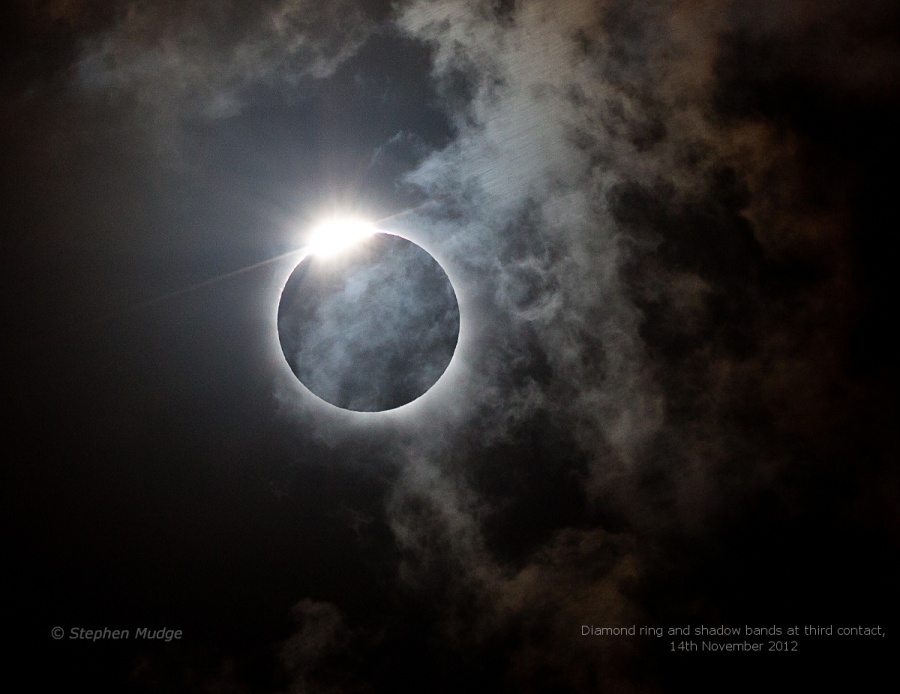 As the total phase of last week's solar eclipse came to an end, sunlight streaming past the edge of the Moon created the fleeting appearance of a glistening diamond ring in the sky. And while most eclipse watchers did not consider clouds a welcome sight, a view through thin clouds north of Cairns in Queensland, Australia also revealed these remarkable flickering shadow bands. Projected onto the cloud layer, the bands are parallel to the sliver of emerging sunlight. Caused by turbulence in Earth's atmosphere refracting the sliver of sunlight, the narrow bands were captured in this brief, 1/1000th second exposure. |
Re: Terry's Astronomy Thread.
What's in the sky tonight?
November 22, 2012 -The Moon is under the Great Square of Pegasus as the stars come out. -Jupiter's moon Io disappears into eclipse by Jupiter's shadow, barely beyond the planet's western edge, at 11:20 p.m. EST (8:20 p.m. PST). Jupiter's Great Red Spot transits the planet's central meridian around 10:16 p.m. EST.  Astro Picture of the Day: November 22, 2012 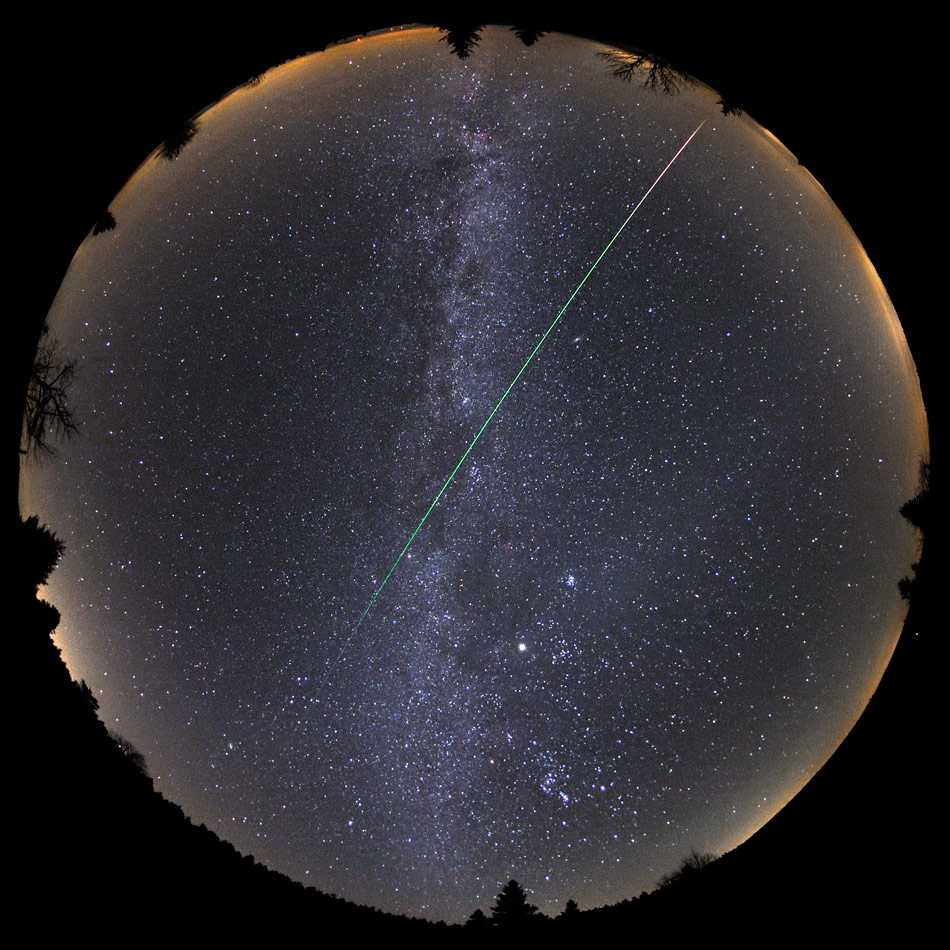 A cosmic grain of sand left the long and colorful trail across this all-sky view. Its grazing impact with planet Earth's atmosphere began at 71 kilometers per second. With the Milky Way stretching from horizon to horizon, the scene was captured on the night of November 17 from the astronomically popular high plateau at Champ du Feu in Alsace, France. Of course, the earthgrazer meteor belongs to this month's Leonid meteor shower, produced as our fair planet annually sweeps through dust from the tail of periodic Comet Tempel-Tuttle. The shower's radiant point in the constellation Leo is very close to the eastern horizon, near the start of the trail at the lower left. Bright planet Jupiter is also easy to spot, immersed in a faint band of Zodiacal light just below and right of center. The image is part of a dramatic time-lapse video that began only 7 minutes before the long leonid crossed the sky. Link to video is here: http://vimeo.com/53980967 |
Re: Terry's Astronomy Thread.
What's in the sky tonight?
November 23, 2012 -Some pre-telescopic astronomy: Sometime between 6:30 and 8:30 this evening, depending on how far east or west you live in your time zone, bright Vega sinking in the northwest and bright Capella climbing in the northeast (well left of brighter Jupiter) will be at exactly the same height. How accurately can you time this event for your location? An astrolabe would help. -Altair is the brightest star in the west-southwest. (It's far lower left of brighter Vega.) Look above Altair, and perhaps a bit left, for the dim but distinctive little constellation Delphinus, the Dolphin. Astro Picture of the Day: November 23, 2012 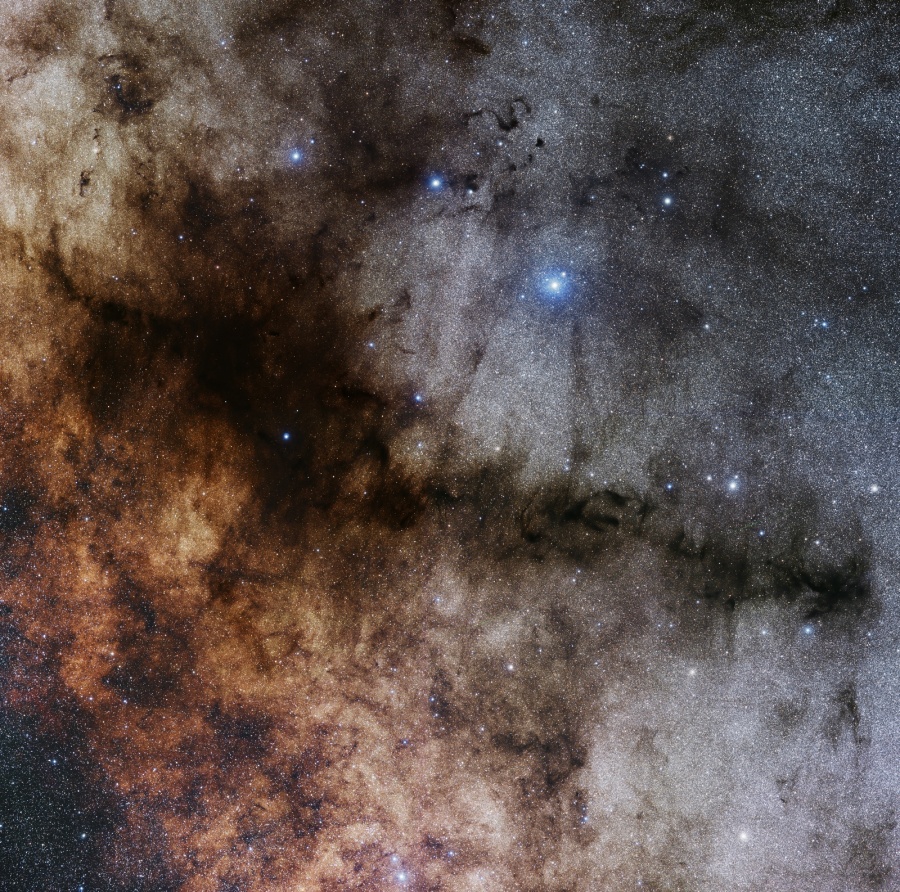 East of Antares, dark markings sprawl through crowded star fields toward the center of our Milky Way Galaxy. Cataloged in the early 20th century by astronomer E. E. Barnard, the obscuring interstellar dust clouds include B59, B72, B77 and B78, seen in silhouette against the starry background. Here, their combined shape suggests a pipe stem and bowl, and so the dark nebula's popular name is the Pipe Nebula. The deep and expansive view was represents nearly 24 hours of exposure time recorded in very dark skies of the Chilean Atacama desert. It covers a full 10 by 10 degree field in the pronounceable constellation Ophiuchus. The Pipe Nebula is part of the Ophiuchus dark cloud complex located at a distance of about 450 light-years. Dense cores of gas and dust within the Pipe Nebula are collapsing to form stars. |
Re: Terry's Astronomy Thread.
What's in the sky tonight?
November 24, 2012 -Look left of the Moon this evening, by a fist-width at arm's length or a little more, for the two or three brightest stars of Aries. -Mercury emerges into dawn view around November 24th or so, brightening from magnitude +1 to 0 this week. Look for it just above the east-southeast horizon in early dawn, far to the lower left of Venus and Saturn as shown here. Mercury is beginning its best apparition of the year for viewers at mid-northern latitudes. Astro Picture of the Day: November 24, 2012  Barred spiral galaxy NGC 1365 is truly a majestic island universe some 200,000 light-years across. Located a mere 60 million light-years away toward the chemical constellation Fornax, NGC 1365 is a dominant member of the well-studied Fornax galaxy cluster. This sharp color image shows intense star forming regions at the ends of the bar and along the spiral arms, and details of dust lanes cutting across the galaxy's bright core. At the core lies a supermassive black hole. Astronomers think NGC 1365's prominent bar plays a crucial role in the galaxy's evolution, drawing gas and dust into a star-forming maelstrom and ultimately feeding material into the central black hole. Discovered on October 27, the position of a bright supernova is indicated in NGC 1365. Cataloged as SN2012fr, the type Ia supernova is the explosion of a white dwarf star. |
Re: Terry's Astronomy Thread.
This thread kicks so much ass
|
Re: Terry's Astronomy Thread.
What's in the sky tonight?
November 25, 2012 -Venus, brilliant at magnitude –3.9, and Saturn, much fainter at magnitude +0.6, shine together in the southeast during dawn. Saturn begins the week 3° to Venus's lower left (on Saturday morning the 24th). It passes about 0.8° by Venus on the 26th and 27th, and by November 30th it's 4° to Venus's upper right. This is a rare opportunity to catch both Venus and Saturn within a moon's field of view of each other, meaning if you have a telescope or binoculars, you will be able to see both planets! -Mercury also joins the show enterring its best apparition of the year for mid-northern latitude viewers, meaning this is the highest Mercury will be visible this year.  Astro Picture of the Day: November 25, 2012  They might look like trees on Mars, but they're not. Groups of dark brown streaks have been photographed by the Mars Reconnaissance Orbiter on melting pinkish sand dunes covered with light frost. The above image was taken in 2008 April near the North Pole of Mars. At that time, dark sand on the interior of Martian sand dunes became more and more visible as the spring Sun melted the lighter carbon dioxide ice. When occurring near the top of a dune, dark sand may cascade down the dune leaving dark surface streaks - streaks that might appear at first to be trees standing in front of the lighter regions, but cast no shadows. Objects about 25 centimeters across are resolved on this image spanning about one kilometer. Close ups of some parts of this image show billowing plumes indicating that the sand slides were occurring even when the image was being taken. |
Re: Terry's Astronomy Thread.
What's in the sky tonight?
November 26, 2012 -As dawn begins on Monday and Tuesday mornings, look southeast to spot bright Venus and fainter Saturn less than 1° apart. As dawn brightens further, look far to their lower left for Mercury.  Astro Picture of the Day: November 26, 2012 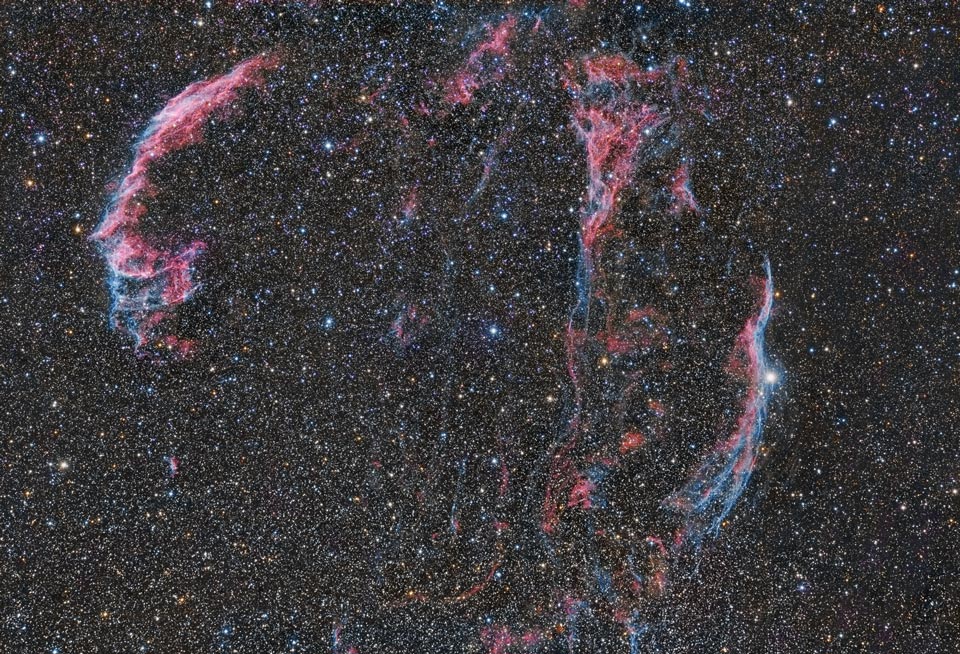 Wisps like this are all that remain visible of a Milky Way star. About 9,000 years ago that star exploded in a supernova leaving the Veil Nebula, also known as the Cygnus Loop. At the time, the expanding cloud was likely as bright as a crescent Moon, remaining visible for weeks to people living at the dawn of recorded history. Today, the resulting supernova remnant has faded and is now visible only through a small telescope directed toward the constellation of the Swan (Cygnus). The remaining Veil Nebula is physically huge, however, and even though it lies about 1,400 light-years distant, it covers over five times the size of the full Moon. In images like this of the complete Veil Nebula, studious readers should be able to identify several of the individual filaments. A bright wisp at the right is known as the Witch's Broom Nebula. |
Re: Terry's Astronomy Thread.
What's in the sky tonight?
November 27, 2012 -Full Moon tonight and tomorrow night. This evening, look lower left of the Moon for Jupiter and orange Aldebaran. Look upper left of the Moon for the fainter Pleiades cluster (binoculars help), and far left for Capella (out of the frame here). -A weak penumbral eclipse of the Moon occurs before and/or during dawn Wednesday morning for western North America. The penumbra is the pale outer fringe of Earth's shadow. The Moon will be deepest in it from 6:18 to 6:48 a.m. PST on Wednesday the 28th (14:18 to 14:48 on the 28th Universal Time). Look for a weak shading on the Moon's north (upper right) side. The farther in from the West Coast you are, the brighter the dawn and the lower the Moon will be. -The penumbral eclipse takes place high in the middle of the night for the longitudes of Australia and Japan, in late evening of the 28th local date for China and Southeast Asia, and early that evening for India with the Moon still low in the east. More details here:   Astro Picture of the Day: November 27, 2012  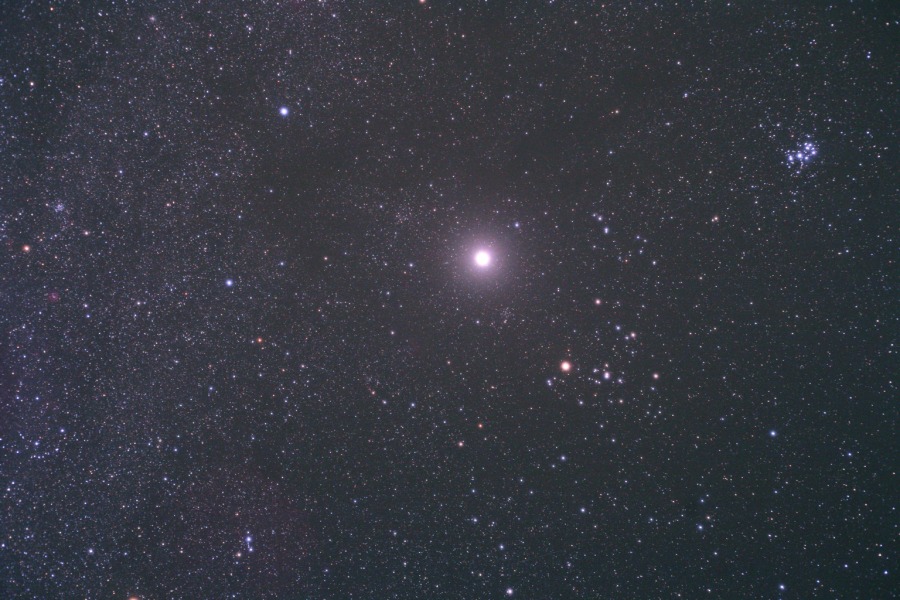 Wisps like this are all that remain visible of a Milky Way star. About 9,000 years ago that star exploded in a supernova leaving the Veil Nebula, also known as the Cygnus Loop. At the time, the expanding cloud was likely as bright as a crescent Moon, remaining visible for weeks to people living at the dawn of recorded history. Today, the resulting supernova remnant has faded and is now visible only through a small telescope directed toward the constellation of the Swan (Cygnus). The remaining Veil Nebula is physically huge, however, and even though it lies about 1,400 light-years distant, it covers over five times the size of the full Moon. In images like this of the complete Veil Nebula, studious readers should be able to identify several of the individual filaments. A bright wisp at the right is known as the Witch's Broom Nebula. |
Re: Terry's Astronomy Thread.
What's in the sky tonight?
November 28, 2012 -The Moon shines close to Jupiter and Aldebaran this evening, with the dimmer Pleiades above them. Think photo opportunity! Use a long (or zoomed) lens, and try a variety of exposures to catch the faint stars as well as the bright Moon. -Mars (magnitude +1.2, in Sagittarius) remains low in the southwest in evening twilight. In a telescope it's just a tiny blob 4.4 arcseconds in diameter.  Astro Picture of the Day: November 28, 2012 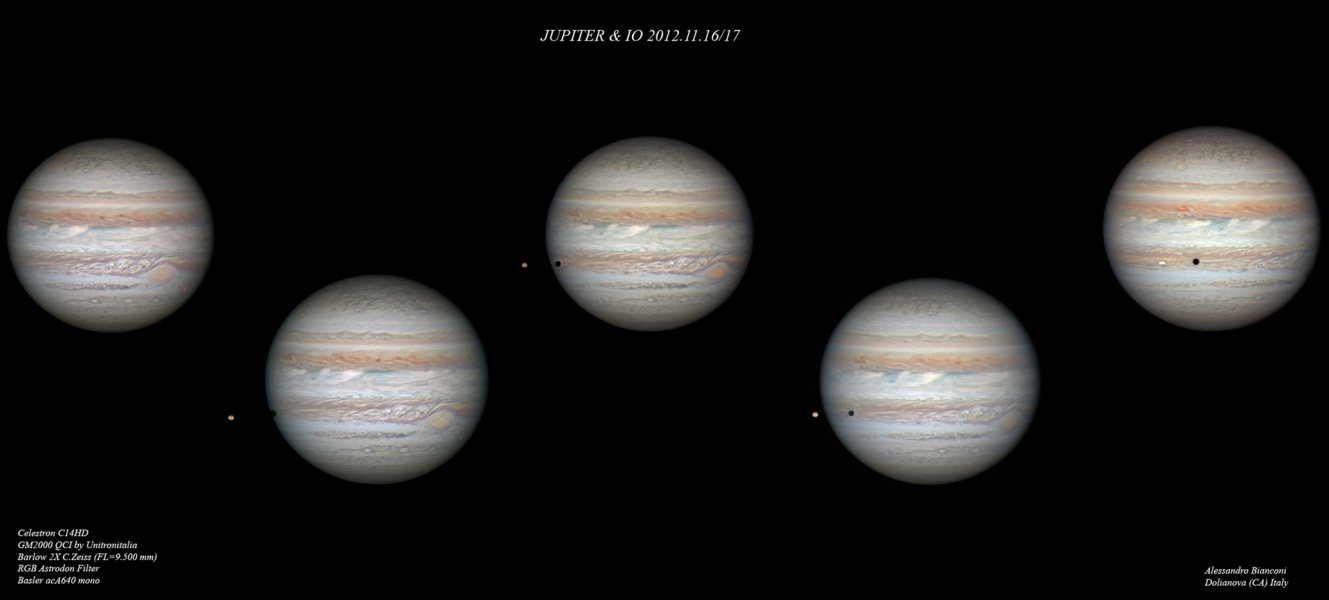 On December 3 (UT), Jupiter, the solar system's largest planet, will be at opposition, opposite the Sun in planet Earth's sky, shining brightly and rising as the Sun sets. That configuration results in Jupiter's almost annual closest approach to planet Earth. So, near opposition the gas giant offers earthbound telescopes stunning views of its stormy, banded atmosphere and large Galilean moons. For example, this sharp series was recorded on the night of November 16/17 from the island of Sardinia near Dolianova, Italy. North is up in the images that show off Jupiter's famous Great Red Spot, and planet girdling dark belts and light zones. Also seen in transit is Jupiter's volcanic moon Io, its round, dark shadow tracking across the Jovian cloud tops as the sequence progresses left to right. |
Re: Terry's Astronomy Thread.
What's in the sky tonight?
November 29, 2012 -After the Moon rises this evening, spot Jupiter and fainter Aldebaran to its upper right, and Capella farther to its upper left. -Jupiter's Great Red Spot should cross Jupiter's central meridian around 11:00 p.m. EST (8:00 p.m. PST). Astro Picture of the Day: November 29, 2012  Did you see the big, bright, beautiful Full Moon Wednesday night? That was actually a Micro Moon! On that night, the smallest Full Moon of 2012 reached its full phase only about 4 hours before apogee, the most distant point from Earth in the Moon's elliptical orbit. Of course, earlier this year on May 6, a Full Super Moon was near perigee, the closest point in its orbit. The relative apparent size of November 28's Micro Moon (right) is compared to the famous May 6 Super Moon in these two panels, matching telescopic images from Bucharest, Romania. The difference in apparent size represents a difference in distance of just under 50,000 kilometers between apogee and perigee, given the Moon's average distance of about 385,000 kilometers. How long do you have to wait to see another Full Micro Moon? Until January 16, 2014, when the lunar full phase will occur within about 3 hours of apogee. |
Re: Terry's Astronomy Thread.
What's in the sky tonight?
November 30, 2012 -The waning Moon rises less than an hour after the end of twilight. Once it's up, look to the right of it (by a bit more than a fist-width at arm's length) for orange-red Betelgeuse sparkling in Orion's rising shoulder.  Astro Picture of the Day: November 30, 2012 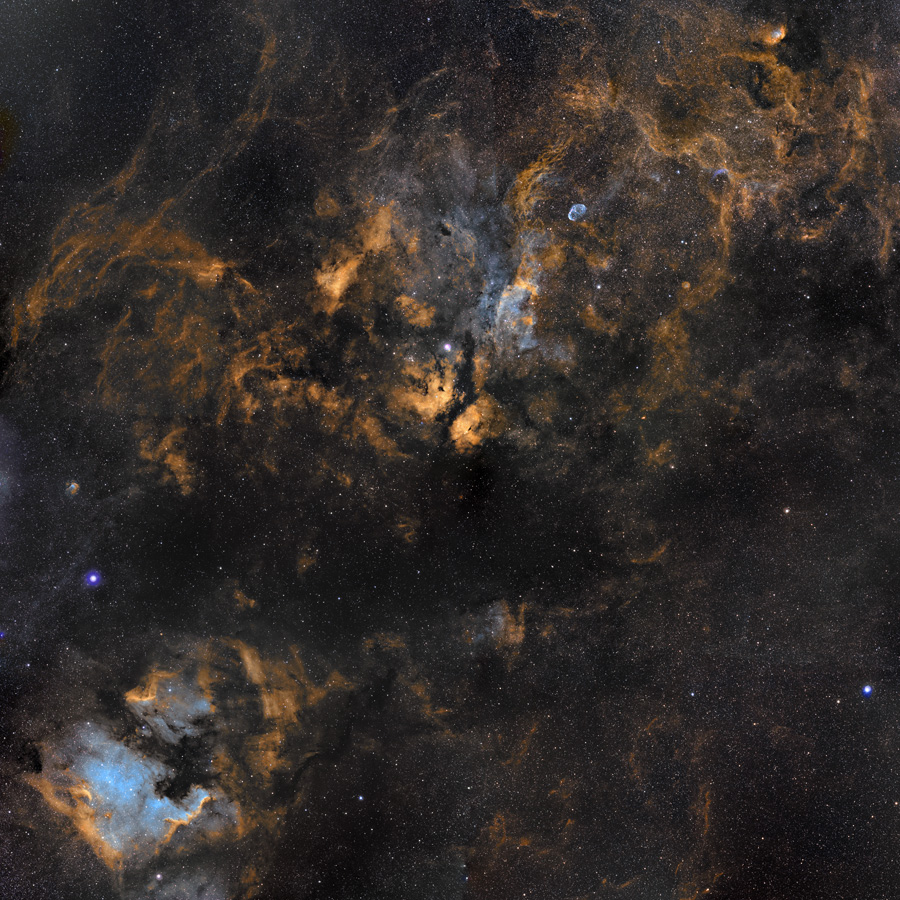 Cosmic clouds of gas and dust drift across this magnificent mosaic covering a 12x12 degree field within the high flying constellation Cygnus. The collaborative skyscape, a combination of broad and narrow band image data presented in the Hubble palette, is anchored by bright, hot, supergiant star Deneb, below center near the left edge. Alpha star of Cygnus, Deneb, is the top of the Northern Cross asterism and is seen here next to the dark void known as the Northern Coal Sack. Below Deneb are the recognizable North America and Pelican nebulae (NGC 7000 and IC 5070). Another supergiant star, Sadr (Gamma Cygni) is near the center of the field just above the bright wings of the Butterfly Nebula. A line continuing up and right will encounter the more compact Crescent Nebula and finally the Tulip Nebula near the top of the frame. Most of these complex nebulosities are located about 2,000 light-years away. Along with the Sun, they lie in the Orion spiral arm of our Milky Way galaxy. |
Re: Terry's Astronomy Thread.
What's in the sky tonight?
December 1, 2012 -Since Jupiter just about at opposition, the asteroids Ceres and Vesta in Jupiter's vicinity are near opposition too. Vesta has brightened to magnitude 6.6, Ceres 7.2.Spot them here. They're near the horns of Taurus. This evening you'll have the darkest view of them shortly before moonrise. (The Moon rises around 7 p.m. depending on your location.) Astro Picture of the Day: December 1, 2012 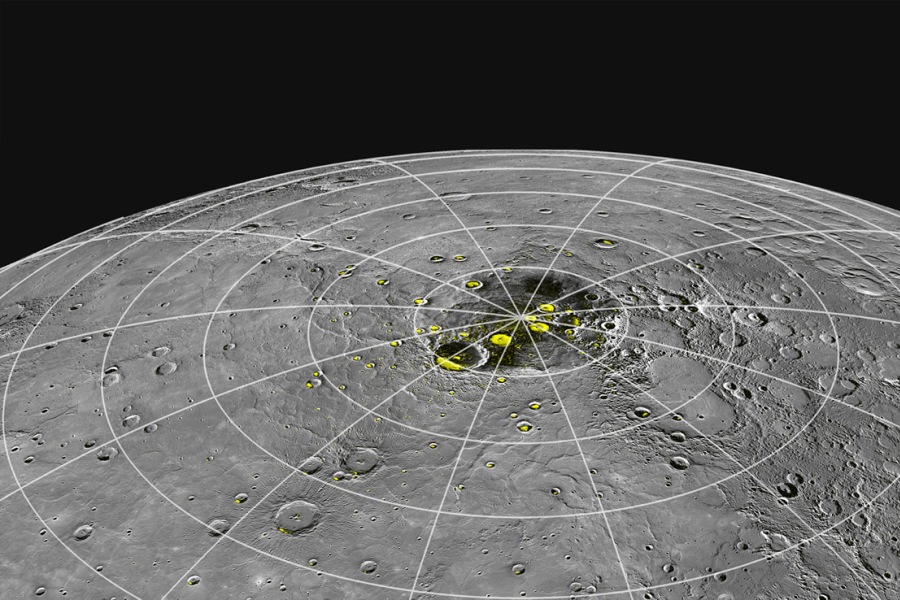 Innermost planet Mercury would probably not be a good location for an interplanetary winter olympics. But new results based on data from the Mercury orbiting MESSENGER spacecraft indicate that it does have substantial water ice in permanently shadowed regions within craters near its north pole. The possibility of ice on Mercury has been entertained for years, inspired by the discovery of radar bright, hence highly reflective, regions near the north pole. Highlighted in yellow in this map based on projected MESSENGER images, radar bright regions are seen to correspond with floors and walls of north polar impact craters. Farther from the pole the regions are concentrated on the north facing crater walls. MESSENGER's neutron spectroscopy and thermal models for the craters indicate material in these regions has a hydrogen content consistent with nearly pure water ice and is trapped in an area with temperatures that remain below 100 kelvins (-280 deg.F, -173 deg.C). In circumstances similar to permanent shadows in craters of the Moon, debris from comet impacts is thought to be the source of ice on Mercury. |
Re: Terry's Astronomy Thread.
What's in the sky tonight?
December 2, 2012 -Jupiter is at opposition tonight: opposite the Sun as seen from Earth. So it rises around sunset, shines highest in the south around midnight, and sets around sunrise. Whenever Jupiter comes to opposition at this time of year, it's shining near Aldebaran and the Pleiades. -Mercury, Venus, and Saturn form a diagonal line in the southeast when dawn behind to brighten. Venus is by far the brightest at magnitude –3.9. Look upper right of it for distant Saturn, magnitude +0.7. Look lower left of Venus for Mercury, magnitude –0.5. Mercury is having an excellent apparition through the first half of December. This diagonal line of three lengthens from 13° to 19° long this week. Added bonus: Look upper right of the planet lineup for Spica, similar to Saturn at magnitude +1.0. Astro Picture of the Day: December 2, 2012 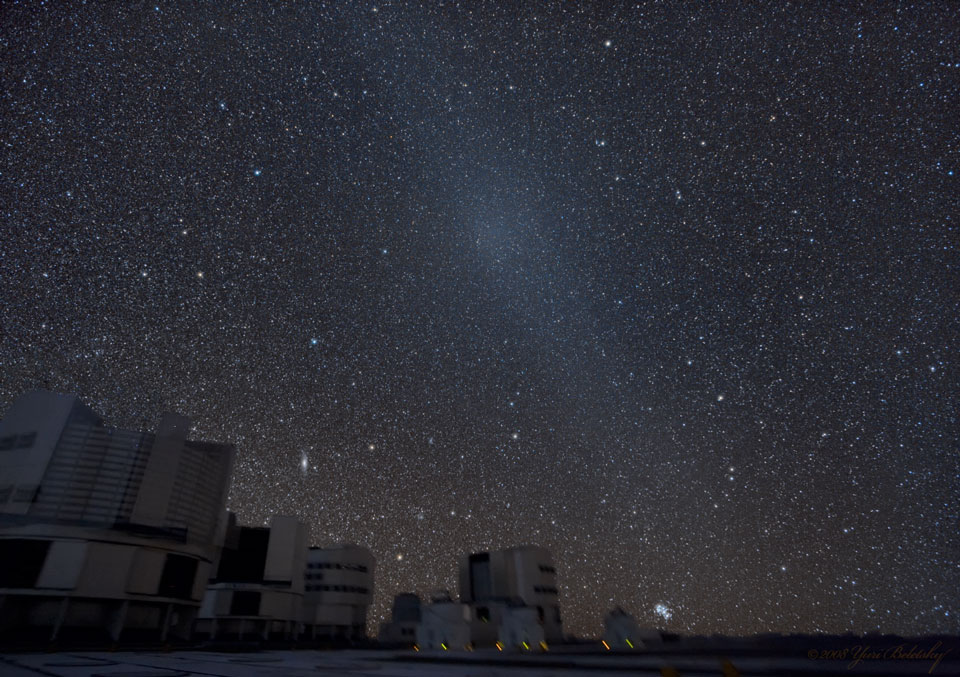 Is the night sky darkest in the direction opposite the Sun? No. In fact, a rarely discernable faint glow known as the gegenschein (German for "counter glow") can be seen 180 degrees around from the Sun in an extremely dark sky. The gegenschein is sunlight back-scattered off small interplanetary dust particles. These dust particles are millimeter sized splinters from asteroids and orbit in the ecliptic plane of the planets. Pictured above from 2008 October is one of the more spectacular pictures of the gegenschein yet taken. Here a deep exposure of an extremely dark sky over Paranal Observatory in Chile shows the gegenschein so clearly that even a surrounding glow is visible. In the foreground are several of the European Southern Observatory's Very Large Telescopes, while notable background objects include the Andromeda galaxy toward the lower left and the Pleiades star cluster just above the horizon. The gegenschein is distinguished from zodiacal light near the Sun by the high angle of reflection. During the day, a phenomenon similar to the gegenschein called the glory can be seen in reflecting air or clouds opposite the Sun from an airplane. The glory is shown below: 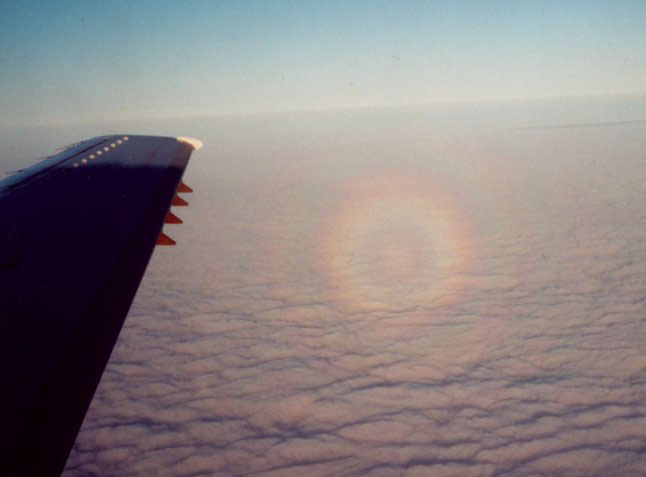 |
Re: Terry's Astronomy Thread.
What's in the sky tonight?
December 3, 2012 -By 8 or 9 p.m., wintry Orion is well up in the east-southeast. Orion's Belt in his middle points up more or less toward Aldebaran and bright Jupiter. And it points down toward where Sirius, the brightest star of the night, is about to rise. Watch for it. -Jupiter (magnitude –2.8, in Taurus) was at opposition yesterday (opposite the Sun as seen from Earth). It rises around sunset, climbs the eastern sky in the evening, shines highest in the south around midnight, and sets in the west around sunrise. Orange Aldebaran is 5° to its lower right during evening. Above them are the Pleiades. In a telescope, Jupiter is big 48 arcseconds wide, essentially as large as ever appears. Astro Picture of the Day: December 3, 2012 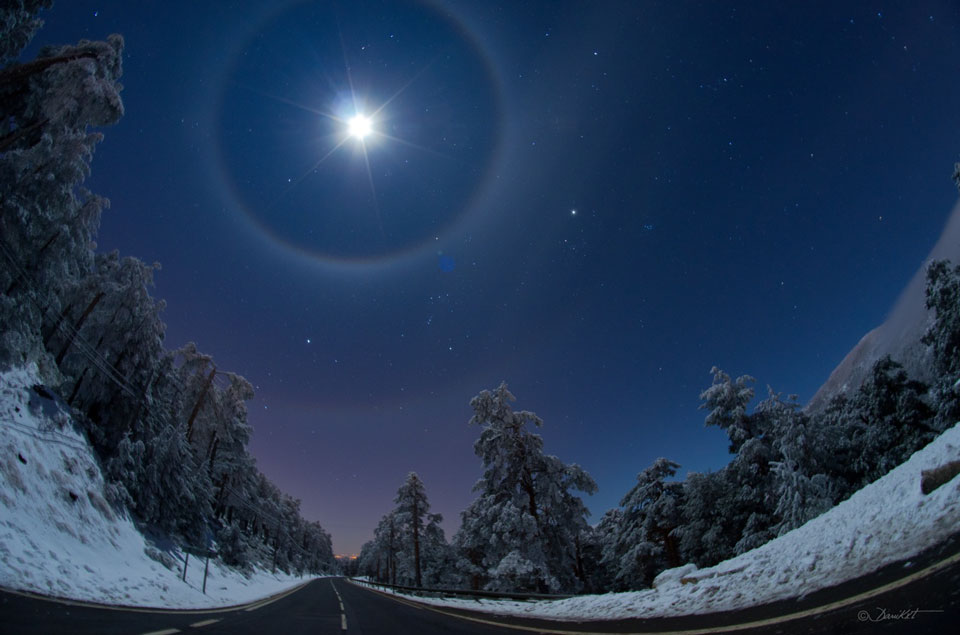  Sometimes falling ice crystals make the atmosphere into a giant lens causing arcs and halos to appear around the Sun or Moon. This past Saturday night was just such a time near Madrid, Spain, where a winter sky displayed not only a bright Moon but as many as four rare lunar halos. The brightest object, near the top of the above image, is the Moon. Light from the Moon refracts through tumbling hexagonal ice crystals into a 22 degree halo seen surrounding the Moon. Elongating the 22 degree arc horizontally is a circumscribed halo caused by column ice crystals. More rare, some moonlight refracts through more distant tumbling ice crystals to form a (third) rainbow-like arc 46 degrees from the Moon and appearing here just above a picturesque winter landscape. Furthermore, part of a whole 46 degree circular halo is also visible, so that an extremely rare - especially for the Moon - quadruple halo was actually imaged. The snow-capped trees in the foreground line the road Puerto de Navacerrada in the Sierra de Guadarrama mountain range near Madrid. Far in the background is a famous winter skyscape that includes Sirius, the belt of Orion, and Betelgeuse all visible between the inner and outer arcs. Halos and arcs typically last for minutes to hours, so if you do see one there should be time to invite family, friends or neighbors to share your unusual lensed vista of the sky. |
Re: Terry's Astronomy Thread.
What's in the sky tonight?
December 4, 2012 -Sometime between 6 and 8 each evening now (depending on how far east or west you live in your time zone), bright Vega sinking in the northwest, and equally bright Capella climbing in the northeast, will be at exactly the same height. How accurately can you time their balance moment for your location? -Mars (magnitude +1.2, in Sagittarius) remains low in the southwest in evening twilight. In a telescope it's just a tiny blob 4.4 arcseconds in diameter. Astro Picture of the Day: December 4, 2012 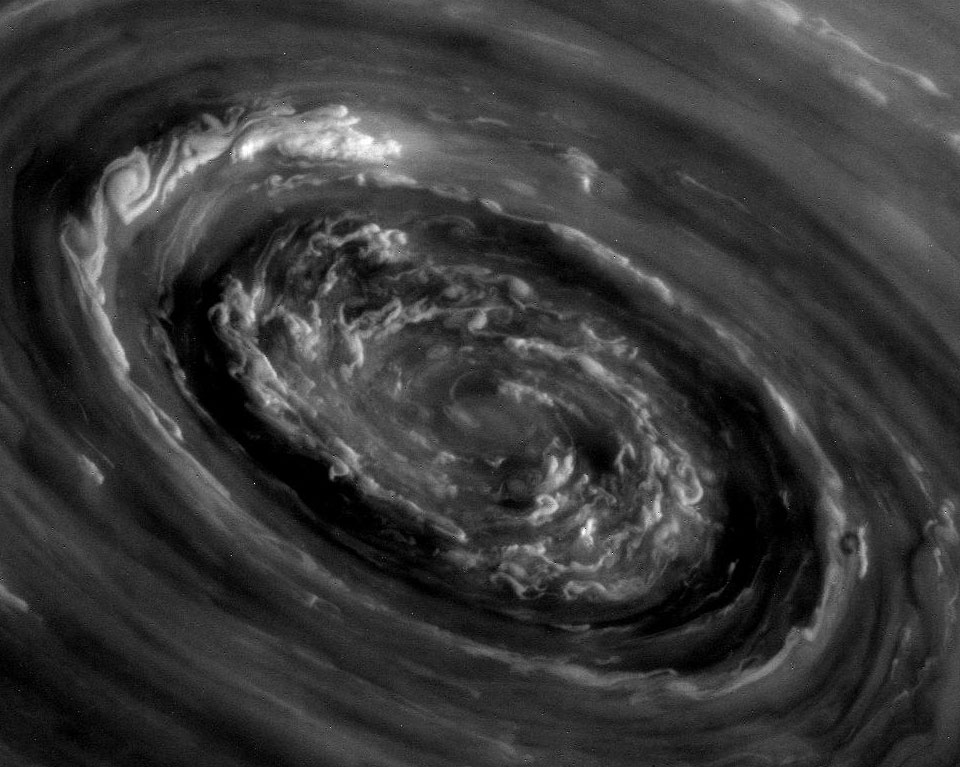 What's happening at the north pole of Saturn? A vortex of strange and complex swirling clouds. The center of this vortex was imaged in unprecedented detail last week by the robotic Cassini spacecraft orbiting Saturn. These clouds lie at the center of the unusual hexagonal cloud system that surrounds the north pole of Saturn. Saturn's north pole precessed into sunlight just a few years ago, with Cassini taking only infrared images of the shadowed region previously. The above image is raw and unprocessed and is being prepared for release in 2013. Several similar images of the region have recently been condensed into a movie. Planetary scientists are sure to continue to study this most unusual cloud formation for quite some time. |
Re: Terry's Astronomy Thread.
What's in the sky tonight?
December 5, 2012 -Ganymede, the largest satellite of Jupiter, crosses Jupiter's face tonight from 9:25 to 11:17 p.m. EST, closely followed by its black shadow from 9:37 to 11:44 p.m. EST. In amateur telescopes, Ganymede's shadow will be much more obvious against Jupiter's bright surface than Ganymede itself is. -Under the "Upcoming Events" tab, you can now observe the positions of both Ceres and Vesta until March. Astro Picture of the Day: December 5, 2012 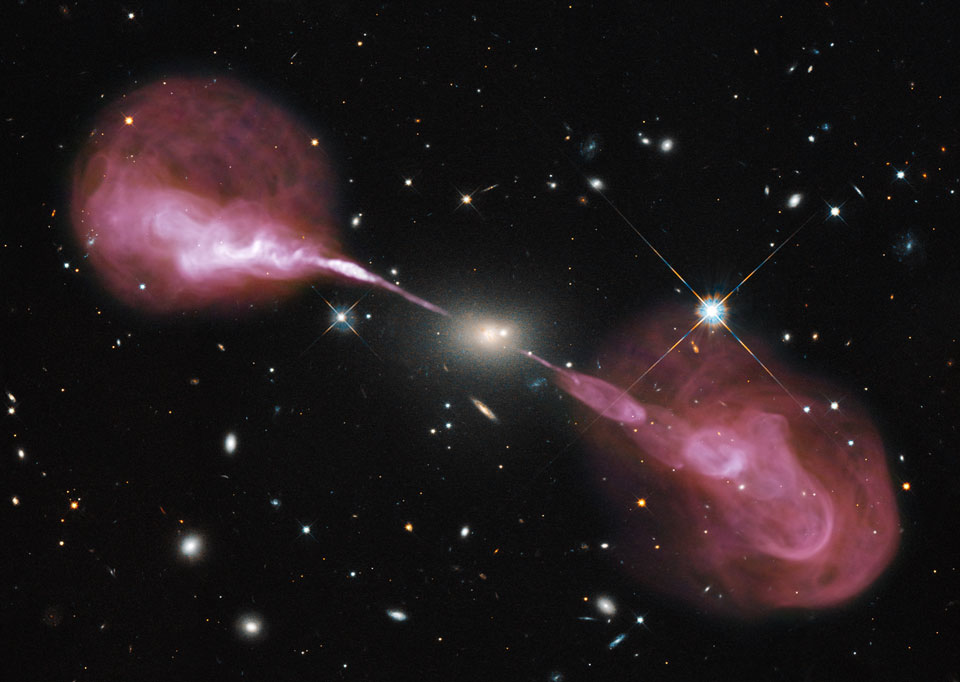 Why does this galaxy emit such spectacular jets? No one is sure, but it is likely related to an active supermassive black hole at its center. The galaxy at the image center, Hercules A, appears to be a relatively normal elliptical galaxy in visible light. When imaged in radio waves, however, tremendous plasma jets over one million light years long appear. Detailed analyses indicate that the central galaxy, also known as 3C 348, is actually over 1,000 times more massive than our Milky Way Galaxy, and the central black hole is nearly 1,000 times more massive than the black hole at our Milky Way's center. Pictured above is a visible light image obtained by the Earth-orbiting Hubble Space Telescope superposed with a radio image taken by the recently upgraded Very Large Array (VLA) of radio telescopes in New Mexico, USA. The physics that creates the jets remains a topic of research with a likely energy source being infalling matter swirling toward the central black hole. |
Re: Terry's Astronomy Thread.
What's in the sky tonight?
December 6, 2012 -Last-quarter Moon (exact at 10:31 a.m). The Moon rises around the middle of the night tonight. In the small hours of Friday morning it climbs the eastern sky beneath Leo. -Jupiter's Great Red Spot crosses Jupiter's central meridian around 11:45 p.m. EST. Astro Picture of the Day: December 6, 2012  Globular star cluster 47 Tucanae is a jewel of the southern sky. Also known as NGC 104, it roams the halo of our Milky Way Galaxy along with around 200 other globular star clusters. The second brightest globular cluster (after Omega Centauri) as seen from planet Earth, it lies about 13,000 light-years away and can be spotted naked-eye near the Small Magellanic Cloud (SMC) in the constellation of the Toucan. Of course, the SMC is some 210,000 light-years distant, a satellite galaxy of our Milky Way and not physically close to 47 Tuc. Stars on the outskirts of the SMC are seen at the upper left of this broad southern skyscape. Toward the lower right with about the same apparent diameter as a Full Moon, dense cluster 47 Tuc is made up of several million stars in a volume only about 120 light-years across. Away from the bright cluster core, the red giants of 47 Tuc are easy to pick out as yellowish tinted stars. Globular cluster 47 Tuc is also home to exotic x-ray binary star systems. |
Re: Terry's Astronomy Thread.
What's in the sky tonight?
December 7, 2012 -This is the time of year when the Andromeda Galaxy, M31, passes the zenith in early evening for skywatchers at mid-northern latitudes. It goes exactly through your zenith if you're at 41° north latitude (New York, Denver). When this happens depends on your location. Astro Picture of the Day: December 7, 2012 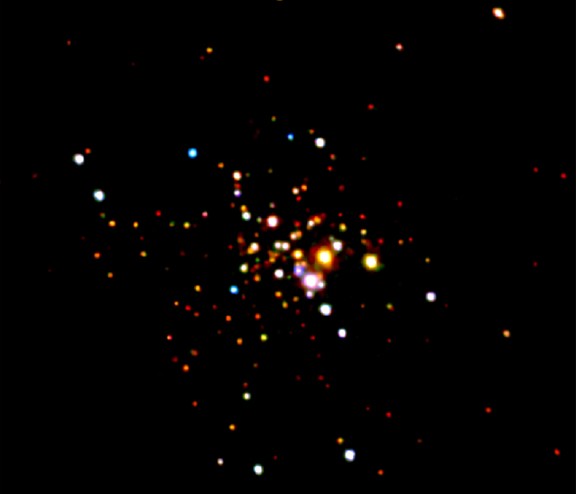 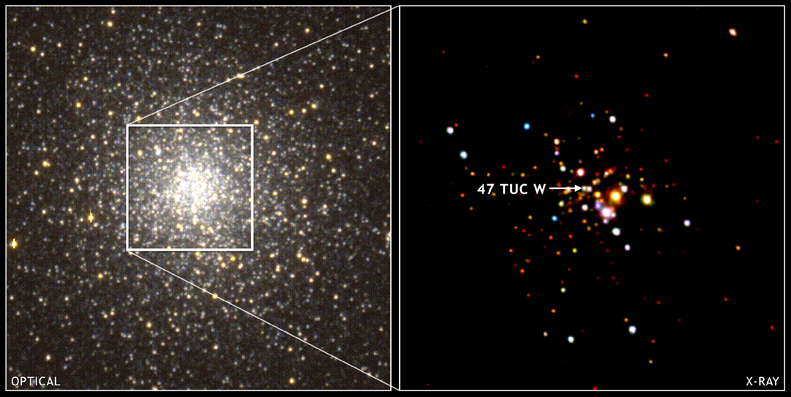 In a continuation from yesterday's picture of the day, we continue with the same globular cluster. Visible light images show the central region of globular cluster 47 Tucanae is closely packed, with stars less than a tenth of a light-year apart. This Chandra false-color x-ray view of central 47 Tuc also shows the cluster is a popular neighborhood for x-ray stars, many of which are "normal" stars co-orbiting with extremely dense neutron stars - stars with the mass of the Sun but the diameter of Manhattan Island. One of the most remarkable of these exotic binary systems is cataloged as 47 Tuc W, a bright source near the center of this image. The system consists of a low mass star and a a neutron star that spins once every 2.35 milliseconds. Such neutron stars are known to radio astronomers as millisecond pulsars, believed to be driven to such rapid rotation by material falling from the normal star onto its dense companion. In fact, x-ray observations of the 47 Tuc W system link this spin-up mechanism observed to operate in other x-ray binary stars with fast rotating millisecond pulsars. Pulsars have their own distinct sound, and it is possible to listen to what a pulsar sounds like via radio waves by clicking the gray triangle on this page which gives you various pulsar recordings. |
Re: Terry's Astronomy Thread.
Thanks for this thread, Blue. I'm enjoying myself catching up on all these posts. Space rules.
|
| All times are GMT -5. The time now is 12:06 PM. |
Powered by vBulletin® Version 3.8.1
Copyright ©2000 - 2024, Jelsoft Enterprises Ltd.
Copyright FlashFlashRevolution